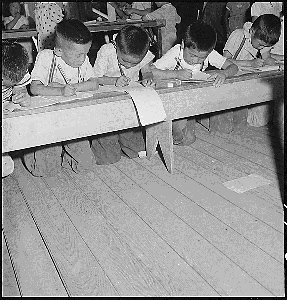
Dorothea Lange, Internment Camp for Japanese-American Citizens during World War II, National Archives.
I’ve discovered a secret about reading histories and criticisms of photography. It’s the iPhone. Or, alternatively an iPad or iTouch.
Almost every book on photography contains a disclaimer from the author that he or she regrets that the practical limits of publication means the book cannot possibly include enough images to give the reader a complete picture of the photographers and genres being discussed.
But, a broad selection of pictures can be found for almost every photographer by a quick web search. I now routinely keep my iPhone at my side while reading and then, when I come to someone I’m not familiar with, or someone whose work I want to see more of, I just Google the name and up pop dozens of images.

Dorothea Lange, Japanese-American children in internment camp during World War II. National Archives.
The majority of photographers are lucky to get one picture in a book. And, for better known artists the same images often show up in history after history (Dorothea Lange’s Migrant Mother, for example).
But, you could read a lot of histories without seeing Lange’s photographs of internment camps for Japanese-Americans during World War II.
I’ve found contemporary photographers whose work, based on a single image in a book, I’ve found less than compelling. But, after looking at a selection, I may not be an enthusiast, but I usually get a better idea of what they are trying to accomplish and why they’ve been included.
How to Read a History of Photography
Dorothea Lange, Internment Camp for Japanese-American Citizens during World War II, National Archives.
I’ve discovered a secret about reading histories and criticisms of photography. It’s the iPhone. Or, alternatively an iPad or iTouch.
Almost every book on photography contains a disclaimer from the author that he or she regrets that the practical limits of publication means the book cannot possibly include enough images to give the reader a complete picture of the photographers and genres being discussed.
But, a broad selection of pictures can be found for almost every photographer by a quick web search. I now routinely keep my iPhone at my side while reading and then, when I come to someone I’m not familiar with, or someone whose work I want to see more of, I just Google the name and up pop dozens of images.
Dorothea Lange, Japanese-American children in internment camp during World War II. National Archives.
The majority of photographers are lucky to get one picture in a book. And, for better known artists the same images often show up in history after history (Dorothea Lange’s Migrant Mother, for example).
But, you could read a lot of histories without seeing Lange’s photographs of internment camps for Japanese-Americans during World War II.
I’ve found contemporary photographers whose work, based on a single image in a book, I’ve found less than compelling. But, after looking at a selection, I may not be an enthusiast, but I usually get a better idea of what they are trying to accomplish and why they’ve been included.
Share this: